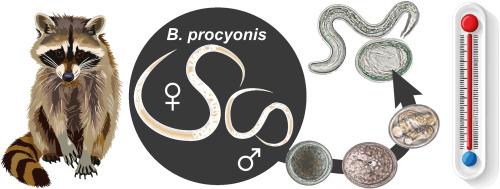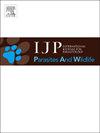环境对浣熊蛔虫(Baylisascaris procyonis)发育的调节作用:温度对胚胎发生的影响
IF 2
3区 医学
Q3 ECOLOGY
International Journal for Parasitology-Parasites and Wildlife
Pub Date : 2024-09-21
DOI:10.1016/j.ijppaw.2024.100997
引用次数: 0
摘要
蛔虫科成员是人类常见的人畜共患病原体,在家畜和畜牧业中发挥着经济作用。蛔虫科包括蛔虫属(Baylisascaris)的寄生线虫,其中最著名的代表是浣熊蛔虫(Baylisascaris procyonis)。浣熊蛔虫以浣熊(Procyon lotor)为主要宿主,也可以利用多种哺乳动物作为副宿主。成体线虫在小肠内进行有性生殖。虫卵通过粪便排泄到环境中,在适宜的条件下几天到几周内发育成感染阶段。初生宿主和副宿主通过口服这些有传染性的虫卵而受到感染。浣熊也可能通过摄入受感染的副寄主而感染。人类是意外宿主,摄入传染性虫卵后会对器官组织、视觉系统和中枢神经系统造成严重损害。本研究旨在调查环境温度对胚胎发育的影响,并记录胚胎发育过程中的形态变化。从浣熊肠道中采集活体标本并进行孵化。在此过程中还收集了单细胞卵。卵经去皮后保存。为了测试环境温度的影响,分别在 5 °C、10 °C、15 °C、20 °C、25 °C、30 °C、35 °C 和 38 °C的温度下孵化卵,并每隔 24 小时监测卵的发育阶段。对发育阶段进行了详细的摄影记录。环境温度升高导致发育时间缩短。胚胎发育至 L1 幼虫阶段的温度范围为 10 °C 至 30 °C。在 5 °C下孵化即使经过 11 个月也不会产生 L1 幼虫。在 35 °C和 38 °C下孵化会导致卵在达到 L1 幼虫阶段之前完全退化。本文章由计算机程序翻译,如有差异,请以英文原文为准。

Environmental modulators on the development of the raccoon roundworm (Baylisascaris procyonis): Effects of temperature on the embryogenesis
Members of the Ascarididae family are common zoonotic pathogens in humans and play an economic role in domestic and livestock animal husbandry. This family includes the obligatorily parasitic nematodes of the genus Baylisascaris, with the raccoon roundworm Baylisascaris procyonis being the most well-known representative. B. procyonis uses the raccoon (Procyon lotor) as its primary host and can utilise a broad range of mammals as paratenic hosts. Sexual reproduction of the adult nematodes occurs in the small intestine. Eggs are excreted into the environment through feces, where they develop into the infectious stage under suitable conditions within a few days to weeks. Infection of primary and paratenic hosts occurs through the oral ingestion of these infectious eggs. Raccoons can also become infected by ingesting infected paratenic hosts. Humans serve as accidental hosts and can suffer significant damage to organ tissues, the visual system, and the central nervous system after ingesting infectious eggs. The aim of the study was to investigate the effects of ambient temperature on embryonic development and to document the morphological changes during embryogenesis. Live specimens were collected from the raccoon intestine and incubated. Single-celled eggs were collected during this process. The eggs were decorticated and then preserved. To test the effects of ambient temperature, the eggs were incubated at 5 °C, 10 °C, 15 °C, 20 °C, 25 °C, 30 °C, 35 °C, and 38 °C and monitored at 24-h intervals for their developmental stages. Detailed photographic documentation of the developmental stages was conducted. An increase in ambient temperature led to a reduction in development time. The temperature range within which embryogenesis proceeded to the L1 larval stage was between 10 °C and 30 °C. Incubation at 5 °C did not produce L1 larvae even after 11 months. Incubation at 35 °C and 38 °C resulted in the complete degeneration of the eggs before reaching the L1 larval stage.
求助全文
通过发布文献求助,成功后即可免费获取论文全文。
去求助
来源期刊

International Journal for Parasitology-Parasites and Wildlife
Medicine-Infectious Diseases
CiteScore
3.80
自引率
5.60%
发文量
113
审稿时长
45 days
期刊介绍:
The International Journal for Parasitology: Parasites and Wildlife (IJP-PAW) publishes the results of original research on parasites of all wildlife, invertebrate and vertebrate. This includes free-ranging, wild populations, as well as captive wildlife, semi-domesticated species (e.g. reindeer) and farmed populations of recently domesticated or wild-captured species (e.g. cultured fishes). Articles on all aspects of wildlife parasitology are welcomed including taxonomy, biodiversity and distribution, ecology and epidemiology, population biology and host-parasite relationships. The impact of parasites on the health and conservation of wildlife is seen as an important area covered by the journal especially the potential role of environmental factors, for example climate. Also important to the journal is ''one health'' and the nature of interactions between wildlife, people and domestic animals, including disease emergence and zoonoses.
 求助内容:
求助内容: 应助结果提醒方式:
应助结果提醒方式:


